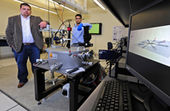
© Lori ZunnoOwners of this state-protected wetland near Oxford, N.Y. learned that a water services company was withdrawing water for use in a nearby gas drilling operation. New York does not uniformly regulate water withdrawals for industrial use and does not have a comprehensive plan to provide the millions of gallons of water needed for proposed drilling of the Marcellus Shale
On May 29 New York state's top environmental officials assured state lawmakers that plans to drill for natural gas near the watershed that supplies New York City's drinking water posed little danger.
A survey of other states had found "
not one instance of drinking water contamination " from the water-intensive, horizontal drilling that would take place across New York's southern tier, the officials told lawmakers in Albany.
Reassured, the legislature quickly approved a bill to speed up the permitting process for a huge influx of wells that could bring the state upwards of $1 billion in annual revenue. Gov. David Paterson has until Wednesday to decide whether he will sign the bill, and the state's Department of Environmental Conservation, or DEC, says drilling permits could be approved in as little as 12 weeks.
But a joint investigation by ProPublica and New York City public radio station WNYC found that
this type of drilling has caused significant environmental harm in other states and could affect the watershed that supplies New York City's drinking water.In New Mexico, oil and gas drilling that uses waste pits comparable to those planned for New York has already caused toxic chemicals to leach into the water table at some 800 sites. Colorado has reported more than 300 spills affecting its ground water.
DEC officials told ProPublica and WNYC they were not aware of those incidents, even though some of the information could have been found through a rudimentary Internet search. The officials couldn't say for sure how New York would dispose of the millions of gallons of hazardous fluids that are byproducts of this type of drilling, and
they learned only recently that the new drilling techniques would pump trace amounts of toxic chemicals into the ground. Four days after one interview, the DEC drafted a
letter to the drilling companies, asking for detailed information about the type and amount of chemicals they will use.



Comment: Perhaps, if it doesn't come smashing on top of your head.